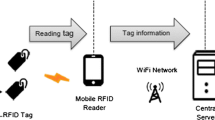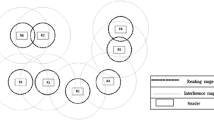Abstract
Today Radio Frequency Identification systems (RFID) are one of the most usable automated wireless identification technologies in the internet of things. Identification systems can exchange data remotely by communicating between a tag and a reader with sending radio waves. The main challenge of identification systems with radiofrequency in a dense RFID network is the collision, which occurs when readers are located in each other's interference range and start reading tags simultaneously. With these collisions happening, readers cannot read all the tags around them in the efficient time durations. In this research, using a distributed method and the channel listening technique, readers select a time interval to take the control channel by the Geometric Probability Distribution Function. Also, by measuring the signal strength from neighboring readers and sharing tag information, there will be an increase in the throughput of identification systems through radio waves while avoiding all kinds of collisions in the control channel. Extensive results show that the proposed method has better throughput and has less average waiting time.









Similar content being viewed by others
Data Availability
Our manuscript has no associated data or the data will not be deposited.
References
Zakeri, F., Golsorkhtabaramiri, M., & Hosseinzadeh, M. (2017). Optimizing radio frequency identification networks planning by using particle swarm optimization algorithm with fuzzy logic controller and mutation. IETE Journal of Research, 63(5), 728–735.
Golsorkhtabaramiri, M., & Issazadehkojidi, N. (2017). A distance based RFID reader collision avoidance protocol for dense reader environments. Wireless Personal Communications, 95(2), 1781–1798.
Rezaie, H., & Golsorkhtabaramiri, M. (2018). A fair reader collision avoidance protocol for RFID dense reader environments. Wireless Networks, 24(6), 1953–1964.
Goel, V., Kumari, P., Shikha, P., Prasad, D., & Nath, V. (2019), Design of smartphone controlled robot using bluetooth, In Nanoelectronics, circuits and communication systems,(pp. 557–563) Springer.
Golsorkhtabaramiri, M., Issazadehkojidi, N., Pouresfehani, N., Mohammadialamoti, M., & Hosseinzadehsadati, S. M. (2018), Comparison of energy consumption for reader anticollision protocols in dense RFID networks, (pp. 1–14).
Nawaz, F., & Jeoti, V. (2015). NFRA-C, neighbor friendly reader to reader anti-collision protocol with counters for dense reader environments. Journal of Network and Computer Applications, 49, 60–67.
Golsorkhtabaramiri, M., Hosseinzadeh, M., Reshadi, M., & Rahmani, A. M. (2015). A reader anti-collision protocol for RFID-enhanced wireless sensor networks. Wireless Personal Communications, 81(2), 893–905.
Assarian, A., Khademzadeh, A., Hosseinzadeh, M., & Setayeshi, S. (2019). An efficient resource allocation scheme in a dense RFID network based on cellular learning automata. International Journal of Communication Systems, 32(1), e3835.
Assarian, A., Khademzadeh, A., HosseinZadeh, M., & Setayeshi, S. (2018). A beacon analysis-based RFID reader anti-collision protocol for dense reader environments. Computer Communications, 128, 18–34.
Liu, B. H., Nguyen, N. T., Pham, V. T., & Yeh, Y. H. (2015). A maximum-weight-independent-set-based algorithm for reader-coverage collision avoidance arrangement in rfid networks. IEEE Sensors Journal, 16(5), 1342–1350.
Bueno-Delgado, M. V., & Pavon-Marino, P. (2013). A centralized and aligned scheduler for passive RFID dense reader environments working under EPCglobal standard. Simulation Modelling Practice and Theory, 34, 172–185.
Ferrero, R., Gandino, F., Montrucchio, B., & Rebaudengo, M. (2014). Improving Colorwave with the probabilistic approach for reader-to-reader anti-collision TDMA protocols. Wireless networks, 20(3), 397–409.
Gandino, F., Ferrero, R., Montrucchio, B., & Rebaudengo, M. (2009). Introducing probability in RFID reader-to-reader anticollision. In Network computing and applications, NCA 2009. Eighth IEEE international symposium on. IEEE.
Klair, D. K., Chin, K. W., & Raad, R. (2010). A survey and tutorial of RFID anti-collision protocols. IEEE Communications Surveys & Tutorials, 12(3), 400–421.
Gandino, F., Ferrero, R., Montrucchio, B., & Rebaudengo, M. (2011). Probabilistic DCS: An RFID reader-to-reader anti-collision protocol. Journal of Network and Computer Applications, 34(3), 821–832.
Yu, J., Lee, W., & Du, D. Z. (2011). Reducing reader collision for mobile RFID. IEEE Transactions on Consumer Electronics, 57(2), 574–582.
Chen, W. T. (2014). A fast anticollision algorithm for the EPCglobal UHF class-1 generation-2 RFID standard. IEEE Communications Letters, 18(9), 1519–1522.
Birari, S. M., & Iyer, S. (2005). PULSE: A MAC protocol for RFID networks. Springer.
Eom, J. B., Yim, S. B., & Lee, T. J. (2009). An efficient reader anticollision algorithm in dense RFID networks with mobile RFID readers. IEEE Transactions on industrial electronics, 56(7), 2326–2336.
Safa, H., El-Hajj, W., & Meguerditchian, C. (2015). A distributed multi-channel reader anti-collision algorithm for RFID environments. Computer Communications, 64, 44–56.
Roberts, C. M. (2006). Radio frequency identification (RFID). Computers & security, 25(1), 18–26.
Jiang, X., Liu, Y., Leng, Y., Liu, J., & Gan, Z. (2012). An efficient and secure RFID-based online monitoring system architecture for enterprise asset management. Journal of Convergence Information Technology, 7(21).
Bueno-Delgado, M. V., Ferrero, R., Gandino, F., Pavon-Marino, P., & Rebaudengo, M. (2012). A geometric distribution reader anti-collision protocol for RFID dense reader environments. IEEE Transactions on Automation Science and Engineering, 10(2), 296–306.
Landt, J. (2005). The history of RFID. IEEE Potentials, 24(4), 8–11.
Saadi, H., Touhami, R., & Yagoub, M. C. (2018). TDMA-SDMA-based RFID algorithm for fast detection and efficient collision avoidance. International Journal of Communication Systems, 31(1), e3392.
Zhang, L., Ferrero, R., Gandino, F., & Rebaudengo, M. (2013). Simulation and evaluation of the interference models for RFID reader-to-reader collisions. In Proceedings of international conference on advances in mobile computing & multimedia, ACM.
Tay, Y. C., Jamieson, K., & Balakrishnan, H. (2004). Collision-minimizing CSMA and its applications to wireless sensor networks. IEEE Journal on Selected Areas in Communications, 22(6), 1048–1057.
Ferrero, R., Gandino, F., Zhang, L., Montrucchio, B., & Rebaudengo, M. (2013). Simulating reader-to-reader interference in RFID systems. In Advanced information networking and applications workshops (WAINA), 27th international conference on, IEEE.
Global, E.J.v. (2008) EPC radio-frequency identity protocols class-1 generation-2 UHF RFID protocol for communications at 860 MHz–960 MHz. 1(0), 23.
ETSI, E.J.R.F.I.E.o.i.t., 302 208–1 V1. 2.1 (2008–04). 865.
Ko, D. H., Kim, B. J., & An, S. S. (2010). Research on anti-reader collision protocols for integrated RFID-WSNs. KSII Transactions on Internet and Information Systems (TIIS), 4(5), 776–798.
Funding
The authors declare that no funds, grants, or other support were received during the preparation of this manuscript.
Author information
Authors and Affiliations
Corresponding author
Ethics declarations
Competing interests
On behalf of all authors, the corresponding author states that there is no conflict of interest.
Additional information
Publisher's Note
Springer Nature remains neutral with regard to jurisdictional claims in published maps and institutional affiliations.
Rights and permissions
About this article
Cite this article
Golsorkhtabaramiri, M., Tahmasbi, M. & Ansari, S. A Distributed Mobile Reader Collision Avoidance Protocol for Dense RFID Networks. Wireless Pers Commun 125, 2719–2735 (2022). https://doi.org/10.1007/s11277-022-09681-3
Accepted:
Published:
Issue Date:
DOI: https://doi.org/10.1007/s11277-022-09681-3




